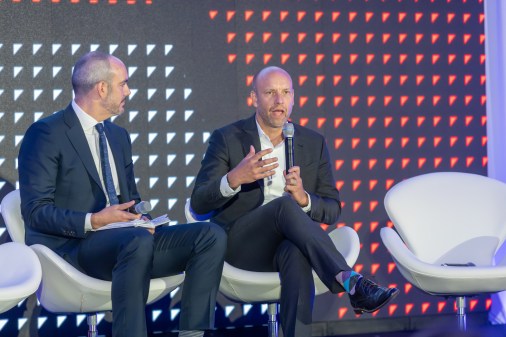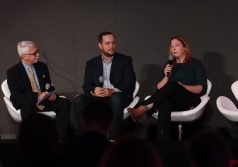FedScoop Q&A: Phaedra Chrousos’ final thoughts leaving GSA

When Phaedra Chrousos joined the General Services Administration in 2014 as its first chief customer officer, she knew she’d only be around for a year or two serving the American taxpayers before heading back to her career as a private sector entrepreneur.
What she didn’t know, however, was that she’d play a critical role during that short time helping launch the Technology Transformation Service, serving as its first commissioner and lending her voice to the often contentious digital services movement sweeping across Washington, D.C.
Now a week away from closing out her chapter as a civil servant, Chrousos chatted with FedScoop about her vision for the Technology Transformation Service, the “obstacle course” she experienced while trying to disrupt government, and why digital services teams in government benefit everyone — including industry — despite all the pushback.
FedScoop: GSA Administrator Denise Roth said the agency’s Technology Transformation Service, which launched two months ago, would not exist today without your “vision and leadership.” So why leave now?
Phaedra Chrousos: That was very kind of her to say. There were many of us involved in this effort, I was probably just the most outspoken.
There’s never a perfect time to leave public service as a political appointee. It’s always tempting to want to climb up one more hill. And then another. But as an appointee, I’m temporary by nature. As a startup entrepreneur I’m a little restless by nature, though I try my best to reign that in. The combination of the two, plus the fact that we just reached a huge milestone — the launch of the Technology Transformation Service, after 10 months of hard work — made this feel like the right time to step away from the role.
It also provides an opportunity for the next commissioner, who we’re actively recruiting for, to come in and take the lead on getting the service from version 1.0 to version 2.0.
FS: Can you talk about the experience standing up the new service?
PC: It definitely took longer than I had expected. Making the case that the government needs an organization that can provide the foundational support for CIOs that want to modernize their technology, while it seems quite logical still challenges the status quo. It opened up an endless number of questions — some philosophical, some tactical — that needed to be answered. We also had to think through how the components of the service — the Office of Citizen Services and Innovative Technologies, the Presidential Innovation Fellows and 18F — would interact with one another so that the sum was greater than the parts, and sketch out a few ways the service could grow and evolve past phase one.
As a startup entrepreneur turned political appointee, standing up the new service ended up being a great fit. I happen to really love building new things where they are the most needed — whether that’s a company in the private sector or an organization in the public sector.
FS: What’s next for the organization now that it’s been launched?
PC: Our vision is that the Technology Transformation Service serves as an evolving arsenal of products and services that federal agencies can use in the massive undertaking that’s underway to repair, rebuild and modernize the government’s technology.
Today, we’re at version 1.0 — a purposefully experimental organization that houses the PIFs, 18F, and OCSIT, and holds products and programs like data.gov, the Web Design Standards and FedRAMP. This version looks and feels like a startup that’s starting to scale — so it’s always pushing boundaries and appears creatively messy as new processes are continually put in place to support its growth.
Versions 2.0, 3.0 and beyond represent an evolution to a larger, more powerful and focused arsenal of products and services that are still constantly evolving to meet the needs of CIOs across federal, state and local governments. Ideally it will still feel like a startup in spirit, but the ecosystem will have matured when it comes to processes and support functions, and so on and so forth.
This next step in the service’s evolution is the need for a seasoned executive — commissioner 2.0, if you will — that can take an organization that’s purposefully experimental and, based on all of the information we’ve gathered about what the government needs, further focus the organization’s resources on the products and services that have the highest impact on the government’s digital movement and generate the greatest savings for the American taxpayer. And they need to do this while navigating the government’s very unique obstacle course.
FS: Talk about those ideas you just mentioned — an “organization that’s purposefully experimental” and “navigating the government’s unique obstacle course.” Can you go into more detail?
PC: These are actually two ideas that I think about a lot. Mostly because they are so often in conflict with one another.
We’re a new organization designed to support an equally new digital movement in the government, so everything the organization does has to be experimental at first. There is no silver bullet to the government’s massive technology modernization undertaking. To develop an arsenal of powerful and relevant products and services for CIOs across government, we have to try out all kinds of bullets — maybe even try out a few bows and arrows — until we better understand what works.
In the case of the Technology Transformation Service, the bullets are products and services that we provide the government. These range from OCSIT’s FedRamp Accelerated, data.gov and the Web Design Standards to service lines in 18F like Custom Partner Solutions and Technology Acquisition Consulting. The arsenal is far from complete, and I hope it never stops evolving to meet the needs of the government.
Now here’s where the conflict lies. To experiment and evolve, you need the freedom to fail fast, small and often. From where I stand, the government is its own unique obstacle course — and almost every obstacle works counter to this idea of failing fast, small and often. Simply put, government’s obstacle course is designed to support risk aversion. Probably for great reason, too, considering so much of government has been established for decades and so much is at risk if something goes wrong. However, for a brand new organization, experimenting while on this obstacle course is a constant and pretty precarious balancing act.
There will be days when the new Technology Transformation Service trips while navigating the obstacle course trying to get a good idea out the door, and other days when the obstacle course slows down or even kills a good idea that could have helped move the government forward.
FS: Despite those challenges, what initiatives have you seen as successful during your two years leading this movement within GSA?
PC: There are absolutely certain approaches that many of us in the digital community, not just me, believe have the highest promise in supporting CIOs in their efforts to modernize. The two that I’m personally passionate about are Technology Acquisition Consulting and the creation of common technical components — like cloud.gov and login.gov — for government. It’s still early, of course, but initial results for these lead us to believe that these two approaches alone may be able to save the government hundreds of millions of dollars a year. And that’s a conservative estimate.
FS: Can you describe those in more detail?
PC: Technology Acquisition Consulting pairs engineers from the Technology Transformation Service and contracting officers from our peer service, the Federal Acquisition Service to provide federal agencies with acquisition support for buying technology smarter. By “buy smarter” I mean buy technology that’s built using modern methodologies — yielding not just better results for the end user, which is often the American public, but also significant cost savings to the government and ultimately the American taxpayer. This same team is also working with the Federal Acquisition Service to create acquisition vehicles that can help government access companies that use or embody modern methodologies. Considering the federal government alone spends $80 billion in IT a year, this is pretty exciting stuff.
The other approach I mentioned — providing common technical components like cloud.gov and login.gov — is a major hat tip to the U.K. government’s Government Digital Service. Like the U.K. government, we believe we can provide government modular, interoperable and secure technical components that any tech team in government can use when they are building out digital services. As a result, this should prevent the government from needing to reinvent a costly wheel hundreds of times over — and interoperability should help mitigate sharing and switching costs.
FS: Given the public conversation that’s been happening around 18F, USDS and the role of the technology industry lately, are these two approaches going to generate more pushback?
PC: If we’re able to explain it clearly, I don’t think they will. The Technology Transformation Service and its components, including 18F, can’t scale their impact without the private sector, and these two approaches are no exception. Every time we help the government rewrite a large technical procurement, industry benefits. Every time we build a new acquisition vehicle that forms a new bridge between the private and public sector, industry benefits. Every time we provide a common technical component, which in both our current cases involves building and buying, industry benefits.
Of course, here’s the rub. The part of industry that benefits from our efforts is the part that employs modern technology methodologies — specifically companies that work in an agile way, put the user first, understand the importance of working in the open, deploy to the cloud, and so on and so forth. At the end of the day, this is something we cannot and should not compromise on. The adoption of those modern technology methods by government delivers a better, more cost effective result for the American public. We have to keep them in mind first and foremost — after all, they’re the ones paying for it.
FS: On a final, personal note. Did you ever think you’d get as much done as you did in the short time you planned to devote to a government tour?
PC: I wish I could have done more. But I came in with the understanding that I was going to sprint for a couple of years before going back to the private sector, rather than run a marathon for 10, 20 years — and I’m happy I did. I gained a tremendous amount of respect for every federal employee that’s running that marathon and serving the public. Now I just hope that the changes that we’ve collectively made last and the vision that we’ve set stays its course.






